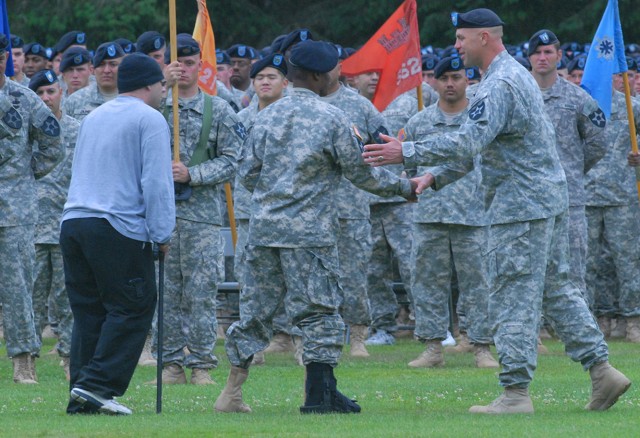JOINT BASE LEWIS-MCCHORD, Wash. - A Stryker brigade whose only commander said was "conceived under the aegis of Mars" retired its flag and welcomed a new leader last week.
The Destroyer Brigade cased its colors July 22 for the first time in its three-year history, when it inactivated to become 2nd Brigade, 2nd Infantry Division.
The morning ceremony on Watkins Field of Joint Base Lewis-McChord served several purposes, but typical of 5th Brigade, 2nd Infantry Division, dispatched multiple requirements.
In addition to witnessing its redesignation, Maj. Gen. John D. Johnson, the I Corps acting commanding general, welcomed the brigade back to the installation after a yearlong deployment that saw some of the most vicious fighting required of American forces in Afghanistan.
Soon after the 2nd Bde. colors unfurled, a new commander took the helm. Colonel Barry Huggins, a combat veteran as a Stryker battalion commander in Iraq, took the reigns of the brigade relinquished by Col. Harry D. Tunnell IV.
And finally, Johnson pinned a Silver Star on the chest of an NCO who, on a hot day last August, performed a series of heroic actions that helped beat back an enemy attack in Arghandab and save the lives of comrades.
The 5th Bde., 2nd Inf. Div. sidestepped tradition when it left JBLM for Afghanistan by symbolically not casing its colors for movement - anticipating its redesignation upon return. But that was only the beginning of a number of events that forced brigade leaders into agile, flexible planning sequences for a changing environment.
Tunnell, his commanders and staff learned during their Mission Readiness Exercise at the National Training Center in Fort Irwin, Calif., the last stop in preparation for combat deployment, that the brigade's mission had changed. After two years of training to support Operation Iraqi Freedom, Tunnell received orders to be the first to lead a Stryker brigade to Afghanistan.
"When our nation called on you to change (mission) focus," Johnson said, "you demonstrated the ability to adapt to a completely different environment ... You were a crucial part and the most visible symbol of American commitment in the surge of additional forces to that theater."
Brigade leaders worked long hours to amend war plans. Tunnell said the biggest challenge was redirecting newly trained Arabic linguists, coordinating crash courses for them in Pashtu to fit the new mission.
The "Strike and Destroy" brigade began operations in Kandahar Province and quickly found itself in combat against a determined, lethal enemy. Thirty-seven 5th Bde. warriors died in combat during the deployment, and 239 suffered wounds. Of those, 95 returned last week to take part in the ceremony. In a moving moment, the wounded warriors complied with Tunnell's order to rejoin their units, some limping and others steering wheel chairs into company formations.
"Our casualties at first were due to the fact we went into places that had not seen large formation of (American Soldiers)," Tunnell said, "places that were infested with Taliban. They used direct fire and (improvised explosive devices) primarily. As time went on we developed better understanding of the environment and were able to share that much more effectively with intelligence. We clearly had the upper hand."
The brigade learned quickly through the late summer, seizing the initiative wherever they went.
Tunnell said his Stryker Soldiers led the assault on Marjah, searched and attacked Taliban in the Arghandab River Valley, repelled enemy fighters in Shah Wali Kot, cleared routes to Uruzgan, helped secure President Karzai in Daykundi, opened lines of communication in Maiwand and Zhari, saturated Zabul, endured dust storms in Helmand and secured the highway from Spin Boldak.
Gaining control of the security situation, they formed relationships that allowed progress with governance and reconstruction assistance, restoring hope for an Afghan future free of Taliban intimidation. The 5th Bde., 2nd Inf. Div. made an immediate impact on the fight in Afghanistan, but its contribution to a lasting resolution might not be realized for a long time. The future of the country is still at issue, but it is clear that the brigade arrived at a crucial time, restoring order to a chaotic and devolving southern part of the country.
"When future historians write about your Afghanistan experience and gain the perspective that only time allows," Johnson said, "it is likely they will recognize the surge of 2009 and 5-2's contributions as a tipping point, pivotal in Operation Enduring Freedom."
Tunnell shared a simple wish for the legacy of the Destroyer Brigade.
"What I hope the citizens of the United States will remember about us is that 5th Bde., 2nd Div., Stryker Bde. Combat Team deployed as part of Operation Enduring Freedom 9-11, so fitting a designation for a team conceived under the aegis of Mars," he said. "I hope they will remember that we lived up to our commitment to the American people by honorably performing our duty in combat."
Don Kramer is a reporter with Joint Base Lewis-McChord's weekly newspaper, the Northwest Guardian.


Social Sharing